Taxonomy SEO – How to Optimize Your WordPress Category Pages
Even for those who’ve been working exhausting to enhance your WordPress web site’s web optimization, it’s possible you’ll not have thought of taxonomy web optimization.
Through the years of attempting completely different web optimization methods, we have now found that optimizing class pages and different taxonomy archives can considerably enhance an internet site’s rankings on search engine outcomes pages (SERPs).
On this article, we are going to present you the right way to optimize your class pages and different taxonomy archives for web optimization in WordPress.

Why Are Class Pages Essential for WordPress web optimization?
In WordPress, taxonomies are used to arrange an internet site’s content material. They allow you to group associated posts collectively, serving to your web site guests shortly discover what they want.
The default WordPress taxonomies are categories, which act as an internet site’s desk of contents, and tags, which might be regarded as an index part.
Some web sites additionally add subcategories and custom taxonomies to type their content material in much more methods. For instance, many eCommerce plugins robotically create a customized Product taxonomy.
When your web site content material is fastidiously organized, guests and search engines like google and yahoo can simply navigate it, leading to happier customers and improved search rankings.
Our information on SEO best practices for sorting your content teaches you the right way to use classes and tags successfully.
However on this tutorial, we are going to give attention to the right way to enhance web optimization by optimizing WordPress class pages.
What Is a Class Web page in WordPress?
Every taxonomy has an archive page that features a title and outline in addition to an inventory of posts contained in that taxonomy.
For instance, our WPBeginner Tutorials class web page has the title ‘700+ Finest Free WordPress Tutorials’. An in depth description follows, the place we clarify how our tutorials provide help to study WordPress to enhance your web site, and we listing some widespread tutorials.
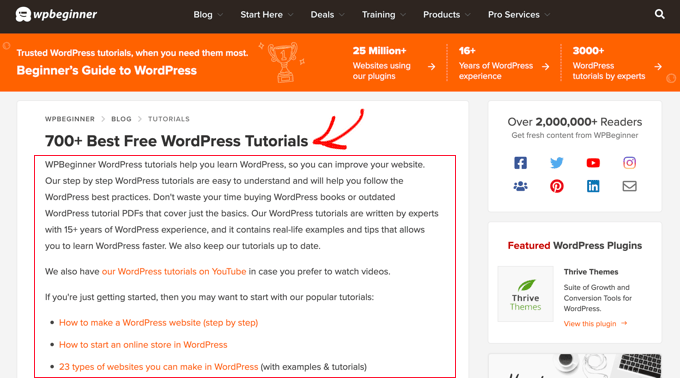
We additionally embody a hyperlink to our YouTube channel for many who choose to observe movies.
After the class description, you can find an inventory of posts within the Tutorials class, beginning with essentially the most just lately printed ones.
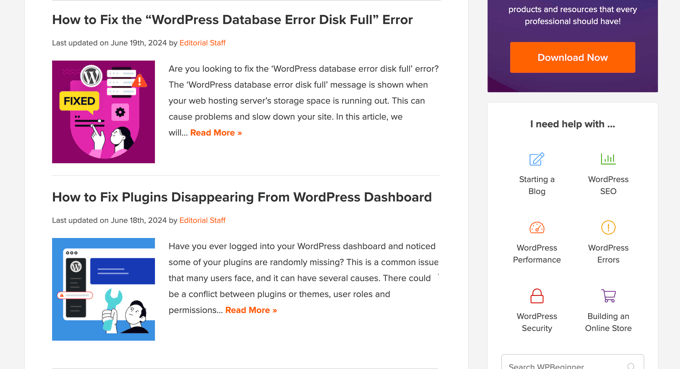
By default, class archive pages are listed by Google and different search engines like google and yahoo.
On this screenshot, you’ll be able to see that our Tutorials class is included in Google search outcomes. The itemizing contains the class web page’s title and outline.

Clicking the hyperlink will take you straight to the Tutorials class web page on WPBeginner.
Bettering Class Web page web optimization in WordPress
Optimizing the content material in your WordPress class pages is an efficient approach to enhance your web site’s web optimization when completed appropriately.
We advocate utilizing the All in One SEO (AIOSEO) WordPress plugin. It’s the best SEO plugin for WordPress and helps you optimize your web site for search engines like google and yahoo without having any technical web optimization information.
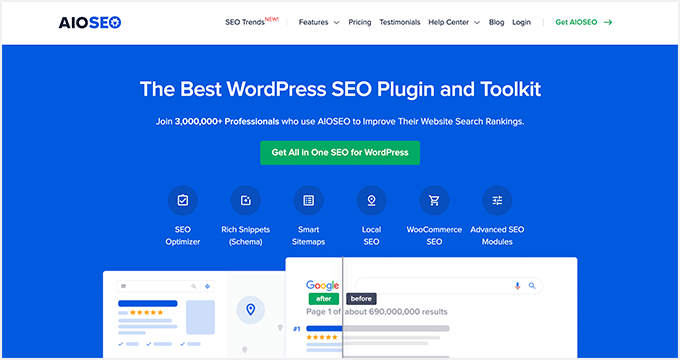
You possibly can entry most of the Taxonomy web optimization options within the AIOSEO free version. Moreover, the premium version of AIOSEO provides superior options like eradicating the class base, optimizing customized taxonomies, TruSEO on-page evaluation for taxonomies, and extra.
You possibly can discover ways to set up and configure AIOSEO in our information on how to set up All in One SEO for WordPress correctly.
Now, let’s check out the right way to optimize class pages and different taxonomy archive pages in WordPress. You should utilize the hyperlinks under to leap to the part you might be most considering:
1. Keep away from Key phrase Cannibalization Between Classes and Posts
One concern with taxonomy web optimization is that your class pages might compete with WordPress posts for a similar key phrase. This is named key phrase cannibalization and might create a complicated state of affairs for search engines like google and yahoo.
We speak extra usually about the right way to repair key phrase cannibalization points in our information on how to improve your organic click-through rate in WordPress.
There are just a few methods to keep away from cannibalization points in relation to class archive pages.
For instance, some web sites target different keywords when optimizing class pages and weblog posts. Different web sites keep away from the issue by asking search engines like google and yahoo to not index classes.
Let’s check out these two approaches so you’ll be able to select the one which most accurately fits your web site.
Selecting To not Index Class and Tag Archive Pages
Some customers cease search engines like google and yahoo from indexing their class and tag archive listings. This encourages search engines like google and yahoo to prioritize their precise posts and pages. It additionally prevents key phrase cannibalization from classes and tags.
You’ll want to navigate to All in One web optimization » Search Look and click on the ‘Taxonomies’ tab.

Now search for the ‘Present in Search’ setting beneath Classes and choose the ‘No’ possibility.
Subsequent, that you must scroll down and do the identical factor for tags.

When you click on the ‘Save Modifications’ button on the prime or backside of the web page, search engines like google and yahoo will not index your class and tag archive pages.
Since they received’t seem in search outcomes, you’ll not have to optimize them for web optimization. Nonetheless, you should still want to observe a few of the steps under to enhance consumer expertise.
Optimizing Classes and Posts for Totally different Key phrases
One other method customers take to stop key phrase cannibalization is to focus on completely different key phrases on taxonomy archive pages and posts.
For instance, think about a assessment web site that covers trainers:
- The class web page for this subject would goal the broad key phrase of ‘Operating Footwear’. The outline might embody an outline of the various kinds of trainers and a purchaser’s information to selecting the best trainers.
- In the meantime, the person posts would assessment particular varieties or fashions of trainers. They could goal long-tail keywords like ‘finest stability trainers’, ‘light-weight trainers for marathons’, and extra.
Through the use of this method, each the class web page and the person posts can rank for related key phrases with out competing with one another.
The class web page will act as a hub, attracting customers with a normal curiosity in trainers. The person opinions shall be displayed on search outcomes for customers with extra particular wants.
This improves the web site’s total web optimization efficiency by concentrating on a wider vary of related key phrases and offering a extra complete consumer expertise.
Tip: When optimizing class pages for web optimization, it’s possible you’ll want to disguise your tags from search engines like google and yahoo utilizing the tactic above. It will guarantee there isn’t a key phrase cannibalization between your classes and tags.
2. Optimize the URL Construction for Classes
Your class URLs must be quick, simple to know, and embody related key phrases. Fortunately, WordPress makes use of an SEO-friendly URL structure for classes, posts, and pages.
By default, your classes could have URLs (or permalinks) that appear like this:
https://instance.com/class/running-shoes/
This URL begins with the web site’s area title adopted by the class base prefix, which is ‘class’. After that, you see a slug that identifies the class.
On this case, that’s ‘running-shoes’, the place a hyphen is robotically used to separate completely different phrases.
This construction works effectively for many web sites. Nonetheless, relying in your wants, you’ll be able to change the bottom to a unique phrase, like ‘subjects’.
Merely go to Settings » Permalinks in WordPress admin and kind the bottom you want to use into the ‘Class base’ area. Be sure you click on the ‘Save Modifications’ button to retailer your settings.

If you happen to change the class base to ‘subjects’, then class permalinks will now appear like this:
https://instance.com/subjects/running-shoes/
Notice that you would be able to change the tag base from ‘tag’ to one thing else on the identical web page.
Some customers choose to utterly take away the class base prefix to simplify their class URLs. The prefix doesn’t have any web optimization profit, and eradicating it shortens the URL and makes it simpler to learn.
You possibly can simply do that utilizing a premium characteristic of All in One web optimization. Merely navigate to All in One web optimization » Search Look after which click on on the ‘Taxonomies’ tab.

Now, beneath the ‘Classes’ part, click on on the ‘Superior’ tab and choose the ‘Sure’ possibility subsequent to ‘Take away Class Base Prefix’.
Your class permalinks will now appear like this:
https://instance.com/running-shoes/
For detailed directions, see our information on how to change the category base prefix in WordPress.
3. Set the Default web optimization Title and Description Format for Classes
All in One web optimization helps you to customise the default format for the way classes seem on search engine outcomes pages.
Yow will discover these settings by navigating to All in One web optimization » Search Look and opening the ‘Taxonomies’ tab.

AIOSEO makes use of dynamic tags to set the default codecs of the web optimization title and outline of your classes.
By default, search engines like google and yahoo will show the title because the class title and web site title. The meta description will merely be the class description.
If you happen to look on the Preview part, you’ll be able to see how this may seem in search outcomes.
These default settings will work for many web sites, however you’ll be able to customise them by including or eradicating dynamic tags.
This format shall be used to set the preliminary meta title and outline of every class. Within the subsequent part, we’ll present you the right way to customise them for particular classes.
4. Add a Useful Title and Description for Every Class
It is best to add a brief description to every class web page to provide customers a greater understanding of the content material they’ll discover.
As you noticed above, class names and descriptions are displayed on search engine outcomes pages and should encourage extra customers to click on your hyperlink.
Moreover that, Google appears for useful and readable content material in your web site when deciding what to rank highest in search outcomes.

First, head over to the Posts » Classes web page in your WordPress dashboard. It will show an inventory of your current classes and subcategories and let you add new categories.
Now that you must click on the ‘Edit’ hyperlink subsequent to the class you want to add content material to.

It will take you to the class edit display screen, the place you’ll be able to add a title, slug, and outline to your class.
The slug shall be utilized in class URLs and must be saved quick and easy. Nonetheless, the class title shall be displayed on the prime of class archive pages, so this may be longer and extra descriptive.
Select a reputation that precisely displays the content material inside that class.

You also needs to add a compelling description of a minimum of 300 phrases that expands on the class title and introduces the subject. This may be just like a weblog publish introduction.
You possibly can write this in plain textual content within the Description area. If you want so as to add headings, formatting, pictures, or hyperlinks to the outline, then you’ll need to make use of HTML code.
For instance, HTML heading tags will appear like this:
<h1>This Is a Foremost Heading</h1>
<h2>This Is a Subheading</h2>
You possibly can add HTML utilizing anchor tags like this:
<a href="https://www.instance.com">click on on this anchor textual content</a>
And you may add pictures like this:
<img src="picture.jpg" alt="An outline of the picture">
Don’t neglect to click on on the ‘Replace’ button to avoid wasting your adjustments.
This class title and outline shall be displayed in your web site and search engine outcomes pages by default.
Alternatively, in case you are utilizing the Pro version of All in One SEO, then you’ll be able to set a unique web optimization title and meta description to your class.
Merely scroll down the class web page till you see the ‘AIOSEO Settings’ part. Right here, you’ll be able to override the default web optimization title and outline codecs you created in part 3 above.
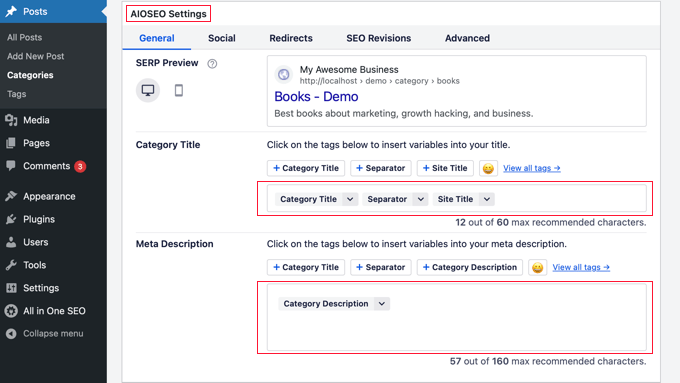
Simply delete all or any dynamic tags and kind the textual content you want to use.
Now, you’ll have to repeat this course of so as to add titles and descriptions to all of your classes. After that, you would possibly love to do the identical factor along with your tags by visiting Posts » Tags.
5. Optimize the Content material of Every Class Description for web optimization
You may also optimize every class description the identical approach you optimize your blog posts for SEO. It will assist your class pages rank larger in search outcomes.
This begins with doing keyword research to guarantee that your class description contains phrases customers are prone to seek for.
Wherever doable, you need to add internal links to enhance navigation and assist search engines like google and yahoo perceive the connection between your classes and posts.
For instance, you can embody hyperlinks to associated classes and subcategories within the description and likewise add hyperlinks to your class pages in associated weblog posts. You may also robotically display subcategories on category pages.
Additionally, just remember to optimize any images you use for search engines.
Lastly, you’ll be able to enhance the headline utilizing AI. Optimizing the class title will make it stand out and inspire customers to click on it once they see it in search outcomes. Probably the greatest methods to do that is utilizing our free Headline Analyzer.
6. Add Breadcrumb Navigation to Your WordPress Web site
Breadcrumbs are an additional navigation system that you would be able to add to your WordPress web site to assist customers discover your content material.
They let customers see the place they’re situated within the hierarchy of your web site. In addition they assist search engines like google and yahoo like Google crawl your web site extra successfully and perceive the construction of your web site. This will help your web site rank larger for related key phrases.
We use breadcrumbs on WPBeginner, and you may see them on each class web page and publish:
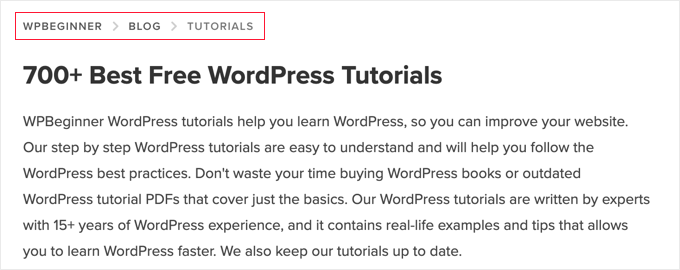
For detailed directions on the right way to add them to your web site, see our information on how to display breadcrumb navigation links in WordPress.
When you’ve got a web based retailer, then you’ll be able to observe our newbie’s information on how to add breadcrumbs in WooCommerce.
Professional Guides Associated to WordPress web optimization
Now that you simply’ve discovered about taxonomy web optimization, it’s possible you’ll wish to see some guides associated to different methods to enhance web site web optimization in WordPress:
We hope this tutorial helped you discover ways to optimize your WordPress class pages. You might also wish to see our information on whether categories or tags are best for SEO or our ultimate guide to WordPress SEO.
If you happen to appreciated this text, then please subscribe to our YouTube Channel for WordPress video tutorials. You may also discover us on Twitter and Facebook.




